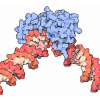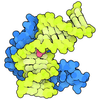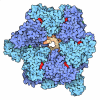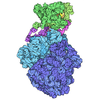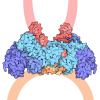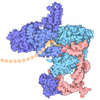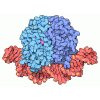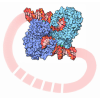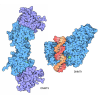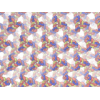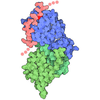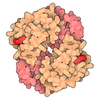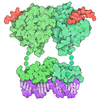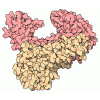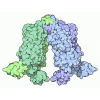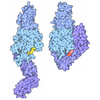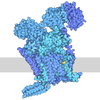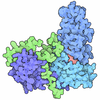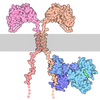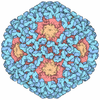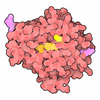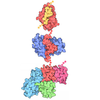+ Open data
Open data
- Basic information
Basic information
| Entry | Database: PDB / ID: 9cg9 | ||||||||||||||||||||||||
|---|---|---|---|---|---|---|---|---|---|---|---|---|---|---|---|---|---|---|---|---|---|---|---|---|---|
| Title | Cryo-EM structure of an HMGB1 box bound to nucleosome at SHL-2 | ||||||||||||||||||||||||
 Components Components |
| ||||||||||||||||||||||||
 Keywords Keywords | DNA BINDING PROTEIN/DNA / nucleosome / high-mobility group box 1 / HMGB1 / DNA BINDING PROTEIN / DNA BINDING PROTEIN-DNA complex | ||||||||||||||||||||||||
| Function / homology |  Function and homology information Function and homology information: / regulation of tolerance induction / calcium-dependent protein kinase regulator activity / positive regulation of myeloid progenitor cell differentiation / regulation of T cell mediated immune response to tumor cell / positive regulation of mismatch repair / negative regulation of apoptotic cell clearance / plasmacytoid dendritic cell activation / negative regulation of RNA polymerase II transcription preinitiation complex assembly / myeloid dendritic cell activation ...: / regulation of tolerance induction / calcium-dependent protein kinase regulator activity / positive regulation of myeloid progenitor cell differentiation / regulation of T cell mediated immune response to tumor cell / positive regulation of mismatch repair / negative regulation of apoptotic cell clearance / plasmacytoid dendritic cell activation / negative regulation of RNA polymerase II transcription preinitiation complex assembly / myeloid dendritic cell activation / T-helper 1 cell activation / T-helper 1 cell differentiation / positive regulation of myeloid cell differentiation / positive regulation of toll-like receptor 2 signaling pathway / positive regulation of dendritic cell differentiation / C-X-C chemokine binding / negative regulation of CD4-positive, alpha-beta T cell differentiation / positive regulation of toll-like receptor 9 signaling pathway / neutrophil clearance / positive regulation of glycogen catabolic process / DNA geometric change / positive regulation of toll-like receptor 4 signaling pathway / endothelial cell chemotaxis / RAGE receptor binding / eye development / positive regulation of interleukin-1 production / Regulation of TLR by endogenous ligand / bubble DNA binding / V(D)J recombination / myeloid cell differentiation / alphav-beta3 integrin-HMGB1 complex / Apoptosis induced DNA fragmentation / myeloid progenitor cell differentiation / inflammatory response to antigenic stimulus / macrophage activation involved in immune response / positive regulation of monocyte chemotaxis / MyD88 deficiency (TLR2/4) / positive regulation of monocyte chemotactic protein-1 production / regulation of nucleotide-excision repair / cellular response to interleukin-7 / endothelial cell proliferation / positive regulation of chemokine (C-X-C motif) ligand 2 production / glycogen catabolic process / apoptotic cell clearance / supercoiled DNA binding / positive regulation of vascular endothelial cell proliferation / IRAK4 deficiency (TLR2/4) / dendritic cell chemotaxis / DNA binding, bending / MyD88:MAL(TIRAP) cascade initiated on plasma membrane / positive regulation of DNA binding / positive regulation of wound healing / phosphatidylserine binding / positive regulation of sprouting angiogenesis / chemoattractant activity / endoplasmic reticulum-Golgi intermediate compartment / positive regulation of activated T cell proliferation / TRAF6 mediated NF-kB activation / negative regulation of type II interferon production / DNA topological change / positive regulation of interferon-alpha production / Advanced glycosylation endproduct receptor signaling / positive regulation of interleukin-10 production / negative regulation of blood vessel endothelial cell migration / positive regulation of blood vessel endothelial cell migration / Pyroptosis / protein kinase activator activity / four-way junction DNA binding / condensed chromosome / DNA polymerase binding / transcription repressor complex / positive regulation of interleukin-12 production / positive regulation of autophagy / activation of innate immune response / positive regulation of interferon-beta production / lung development / response to glucocorticoid / positive regulation of interleukin-1 beta production / cytokine activity / positive regulation of interleukin-8 production / positive regulation of JNK cascade / lipopolysaccharide binding / positive regulation of non-canonical NF-kappaB signal transduction / TAK1-dependent IKK and NF-kappa-B activation / base-excision repair / double-strand break repair via nonhomologous end joining / positive regulation of interleukin-6 production / autophagy / integrin binding / neuron projection development / positive regulation of tumor necrosis factor production / structural constituent of chromatin / transcription corepressor activity / nucleosome / heterochromatin formation / double-strand break repair / nucleosome assembly / single-stranded DNA binding / double-stranded RNA binding / cellular response to lipopolysaccharide Similarity search - Function | ||||||||||||||||||||||||
| Biological species |  Homo sapiens (human) Homo sapiens (human)synthetic construct (others) | ||||||||||||||||||||||||
| Method | ELECTRON MICROSCOPY / single particle reconstruction / cryo EM / Resolution: 2.94 Å | ||||||||||||||||||||||||
 Authors Authors | Chio, U.S. / Saunders, H.S. / Narlikar, G.J. / Cheng, Y. | ||||||||||||||||||||||||
| Funding support |  United States, 4items United States, 4items
| ||||||||||||||||||||||||
 Citation Citation |  Journal: To Be Published Journal: To Be PublishedTitle: Competition between HMGB1 and H1 on nucleosomes tunes dynamics within condensed chromatin Authors: Saunders, H.S. / Chio, U.S. / Moore, C.M. / Ramani, V. / Cheng, Y. / Narlikar, G.J. | ||||||||||||||||||||||||
| History |
|
- Structure visualization
Structure visualization
| Structure viewer | Molecule:  Molmil Molmil Jmol/JSmol Jmol/JSmol |
|---|
- Downloads & links
Downloads & links
- Download
Download
| PDBx/mmCIF format |  9cg9.cif.gz 9cg9.cif.gz | 500.5 KB | Display |  PDBx/mmCIF format PDBx/mmCIF format |
|---|---|---|---|---|
| PDB format |  pdb9cg9.ent.gz pdb9cg9.ent.gz | 392 KB | Display |  PDB format PDB format |
| PDBx/mmJSON format |  9cg9.json.gz 9cg9.json.gz | Tree view |  PDBx/mmJSON format PDBx/mmJSON format | |
| Others |  Other downloads Other downloads |
-Validation report
| Arichive directory |  https://data.pdbj.org/pub/pdb/validation_reports/cg/9cg9 https://data.pdbj.org/pub/pdb/validation_reports/cg/9cg9 ftp://data.pdbj.org/pub/pdb/validation_reports/cg/9cg9 ftp://data.pdbj.org/pub/pdb/validation_reports/cg/9cg9 | HTTPS FTP |
|---|
-Related structure data
| Related structure data |  45578MC M: map data used to model this data C: citing same article ( |
|---|---|
| Similar structure data | Similarity search - Function & homology  F&H Search F&H Search |
- Links
Links
- Assembly
Assembly
| Deposited unit | 
|
|---|---|
| 1 |
|
- Components
Components
-Protein , 5 types, 9 molecules AEBFCGDHK
| #1: Protein | Mass: 15271.863 Da / Num. of mol.: 2 / Mutation: G102A, C110A Source method: isolated from a genetically manipulated source Source: (gene. exp.)  #2: Protein | Mass: 11263.231 Da / Num. of mol.: 2 Source method: isolated from a genetically manipulated source Source: (gene. exp.)  #3: Protein | Mass: 13978.241 Da / Num. of mol.: 2 / Mutation: G99R, A123S Source method: isolated from a genetically manipulated source Source: (gene. exp.)  #4: Protein | Mass: 13524.752 Da / Num. of mol.: 2 / Mutation: S32T Source method: isolated from a genetically manipulated source Source: (gene. exp.)  #7: Protein | | Mass: 25092.049 Da / Num. of mol.: 1 Source method: isolated from a genetically manipulated source Source: (gene. exp.)  Homo sapiens (human) / Gene: HMGB1, HMG1 / Production host: Homo sapiens (human) / Gene: HMGB1, HMG1 / Production host:  |
|---|
-Widom 601 DNA ... , 2 types, 2 molecules IJ
| #5: DNA chain | Mass: 47746.418 Da / Num. of mol.: 1 / Source method: obtained synthetically / Details: 10 base pairs flanking DNA / Source: (synth.) synthetic construct (others) |
|---|---|
| #6: DNA chain | Mass: 47328.148 Da / Num. of mol.: 1 / Source method: obtained synthetically / Details: 10 base pairs flanking DNA / Source: (synth.) synthetic construct (others) |
-Details
| Has protein modification | N |
|---|
-Experimental details
-Experiment
| Experiment | Method: ELECTRON MICROSCOPY |
|---|---|
| EM experiment | Aggregation state: PARTICLE / 3D reconstruction method: single particle reconstruction |
- Sample preparation
Sample preparation
| Component |
| ||||||||||||||||||||||||||||||
|---|---|---|---|---|---|---|---|---|---|---|---|---|---|---|---|---|---|---|---|---|---|---|---|---|---|---|---|---|---|---|---|
| Molecular weight |
| ||||||||||||||||||||||||||||||
| Source (natural) |
| ||||||||||||||||||||||||||||||
| Source (recombinant) |
| ||||||||||||||||||||||||||||||
| Buffer solution | pH: 7.5 | ||||||||||||||||||||||||||||||
| Buffer component |
| ||||||||||||||||||||||||||||||
| Specimen | Embedding applied: NO / Shadowing applied: NO / Staining applied: NO / Vitrification applied: YES Details: 1 uM nucleosome was mixed with 12 uM HMGB1 prior to plunge freezing. | ||||||||||||||||||||||||||||||
| Specimen support | Grid material: GOLD / Grid mesh size: 200 divisions/in. / Grid type: Quantifoil R1.2/1.3 | ||||||||||||||||||||||||||||||
| Vitrification | Instrument: FEI VITROBOT MARK IV / Cryogen name: ETHANE / Humidity: 100 % / Chamber temperature: 278 K / Details: 3 uL of sample was applied to grid. |
- Electron microscopy imaging
Electron microscopy imaging
| Experimental equipment |  Model: Titan Krios / Image courtesy: FEI Company |
|---|---|
| Microscopy | Model: FEI TITAN KRIOS |
| Electron gun | Electron source:  FIELD EMISSION GUN / Accelerating voltage: 300 kV / Illumination mode: FLOOD BEAM FIELD EMISSION GUN / Accelerating voltage: 300 kV / Illumination mode: FLOOD BEAM |
| Electron lens | Mode: BRIGHT FIELD / Nominal magnification: 105000 X / Nominal defocus max: 2000 nm / Nominal defocus min: 800 nm / Cs: 2.7 mm / C2 aperture diameter: 70 µm / Alignment procedure: COMA FREE |
| Specimen holder | Cryogen: NITROGEN / Specimen holder model: FEI TITAN KRIOS AUTOGRID HOLDER |
| Image recording | Average exposure time: 2.024 sec. / Electron dose: 43 e/Å2 / Film or detector model: GATAN K3 BIOQUANTUM (6k x 4k) / Num. of grids imaged: 2 / Num. of real images: 8259 |
| EM imaging optics | Energyfilter name: GIF Bioquantum / Energyfilter slit width: 20 eV |
- Processing
Processing
| EM software |
| ||||||||||||||||||||||||||||||
|---|---|---|---|---|---|---|---|---|---|---|---|---|---|---|---|---|---|---|---|---|---|---|---|---|---|---|---|---|---|---|---|
| CTF correction | Type: PHASE FLIPPING AND AMPLITUDE CORRECTION | ||||||||||||||||||||||||||||||
| Symmetry | Point symmetry: C1 (asymmetric) | ||||||||||||||||||||||||||||||
| 3D reconstruction | Resolution: 2.94 Å / Resolution method: FSC 0.143 CUT-OFF / Num. of particles: 42115 / Symmetry type: POINT |
 Movie
Movie Controller
Controller



 PDBj
PDBj